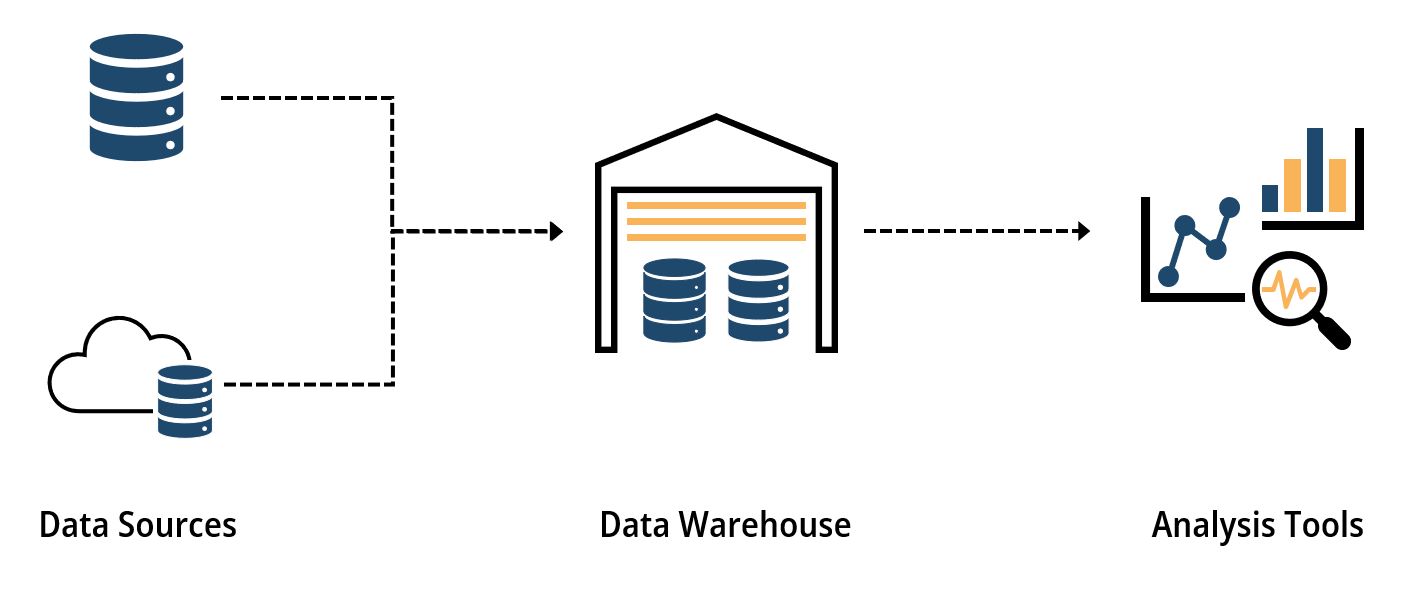Was ist ein Data Warehouse?
Da sich Unternehmen bei ihren Entscheidungsprozessen zunehmend auf Daten stützen, ist ein möglichst genauer Überblick über ihre Daten heute wichtiger denn je. Hier kommt ein Data Warehouse (DWH) ins Spiel. Ein Data Warehouse ist ein zentrales Verzeichnis, in dem Unternehmen ihre Daten aus verschiedenen Quellen an einem bestimmten Ort speichern, verwalten und analysieren können. Dies ermöglicht es Unternehmen nicht nur, eine einzige Informationsquelle für ihre Daten zu haben, sondern bietet auch eine hervorragende Grundlage für erweiterte Analysen und Business Intelligence.
In diesem Blog-Beitrag stellen wir Ihnen das Konzept des Data Warehouse vor und erklären, wie mehrere Datenquellen in einer zentralen Datenbank zusammengeführt werden können. Wir diskutieren ETL-Prozesse und erkunden die Möglichkeiten für Business Intelligence und Analytics. Am Ende dieses Blogbeitrags werden Sie die Vorteile eines Data Warehouse für Ihr Unternehmen besser verstehen und wissen, wie wir Ihnen helfen können, Ihre Ziele im Bereich Dateninfrastruktur zu erreichen.
Architektur eines Data Warehouse (DWH)
Ein DWH ist ein zentraler Speicher für alle Unternehmensdaten, die für die Analyse und das Reporting verwendet werden. Es ist so konzipiert, dass es eine konsistente und zuverlässige Datenquelle darstellt, die für fundierte Geschäftsentscheidungen genutzt werden kann. Die Architektur eines DWH setzt sich aus drei Hauptbestandteilen zusammen: Datenquellen, Datenspeicher und Datenanalyse.
Datenquellen sind der Startpunkt für jedes DWH. Datenquellen bezeichnen zum Beispiel das interne ERP- oder CRM-System sowie externe Quellen wie Kundenbefragungen oder Marktinformationen. Damit das DWH einen Mehrwert liefert, müssen alle relevanten Datenquellen berücksichtigt werden.
Sobald die Datenquellen identifiziert und integriert sind, werden die darin befindlichen Daten in einem Data Warehousezusammengeführt. Dabei werden die Daten in ein einheitliches Format umgewandelt, das für Analysen und Berichte optimiert ist. Data Warehouses verwenden in der Regel ein Stern- oder Schneeflockenschema zur Strukturierung der Daten, was eine schnelle und effiziente Abfrage großer Datenmengen ermöglicht.
Die letzte Komponente einer Data-Warehouse-Architektur ist die Datenanalyse. Um die Datenanalyse durchzuführen, wird Analysesoftware benötigt. Die Analyse-Tools können von einfachen Reporting-Tools bis hin zu fortschrittlicheren Business-Intelligence-Plattformen reichen, die eine Datenexploration und -visualisierung ermöglichen.
Durch die Kombination dieser drei Komponenten in einer gut durchdachten Architektur kann ein Data Warehouse Unternehmen einen umfassenden Überblick über ihre Daten bieten, der zur Entscheidungsfindung, zur Identifizierung neuer Möglichkeiten und zur Förderung des Wachstums genutzt werden kann.
OLAP vs OLTP
Im Zusammenhang mit einem DWH ist es wichtig, den Unterschied zwischen Online Analytical Processing (OLAP) und Online Transaction Processing (OLTP) zu verstehen. Zwar sind beide wichtige Komponenten der Datenverwaltung, doch dienen sie unterschiedlichen Zwecken und sind für die Verarbeitung verschiedener Datentypen konzipiert.
OLAP ist für die Analyse und Berichterstattung über große Datenmengen konzipiert. Sie sind für komplexe Abfragen optimiert und bieten eine Möglichkeit, Daten zusammenzufassen und zu aggregieren, um Business Intelligence und Analysen zu unterstützen. OLAP-Datenbanken sind in der Regel leselastig, d. h. sie sind eher für Abfragen als für das Einfügen oder Aktualisieren von Daten optimiert.
OLTP hingegen ist für die Verarbeitung und Verwaltung von Transaktionsdaten konzipiert. Es ist für die Verarbeitung kleiner, häufiger Transaktionen optimiert, z. B. die Aktualisierung von Kundendatensätzen oder die Bearbeitung von Bestellungen. OLTP-Datenbanken sind in der Regel schreiblastig, d. h. sie sind für das Einfügen, Aktualisieren und Löschen von Daten optimiert, nicht für deren Abfrage.
Der Hauptunterschied zwischen OLAP und OLTP besteht in der Art der Daten, die sie verarbeiten sollen. OLAP ist für die Analyse von Daten und die Erstellung von Berichten konzipiert, während OLTP für die Verarbeitung und Verwaltung von Transaktionsdaten konzipiert ist.
Im Kontext eines DWH werden OLAP-Datenbanken zur Speicherung historischer Daten verwendet, die für Berichte und Analysen umgewandelt und aggregiert wurden. OLTP-Datenbanken hingegen werden für die Speicherung aktueller Transaktionsdaten verwendet, die vom Unternehmen generiert werden.
Vorteile eines Data Warehouse
Ein Data Warehouse bietet mehrere Vorteile für Unternehmen, zum Beispiel:
- Single Source of Truth: Ein Data Warehouse dient als zentraler Speicher für alle Daten eines Unternehmens und stellt eine einzige Quelle der Wahrheit für die Entscheidungsfindung dar. Dadurch wird sichergestellt, dass alle Benutzer Zugang zu denselben genauen und konsistenten Daten haben, was das Risiko von Fehlern und Unstimmigkeiten verringert.
- Verbesserte Datenqualität: Durch die Konsolidierung von Daten aus verschiedenen Quellen ermöglicht ein Data Warehouse den Unternehmen, die Qualität ihrer Daten zu verbessern. Dies wird durch Datenbereinigung und -umwandlung erreicht, die Datenformate standardisieren, Duplikate beseitigen und Diskrepanzen auflösen.
- Effiziente Datenabfragen: Ein Data Warehouse ist für Abfragen und Analysen optimiert und bietet im Vergleich zu herkömmlichen transaktionalen Datenbanken eine schnellere Abfrageleistung. Dies wird durch den Einsatz von Indizierung, Partitionierung und anderen Optimierungstechniken erreicht.
- Einfache Analyse und Reporting: Mit einem Data Warehouse können Unternehmen problemlos Analysen und Berichte über ihre Daten erstellen. Dies wird durch den Einsatz von Business-Intelligence- und Analysetools erreicht, die leistungsstarke Visualisierungs- und Berichtsfunktionen bieten.
- Datensicherheit: Ein Data Warehouse bietet im Vergleich zu herkömmlichen Transaktionsdatenbanken eine höhere Datensicherheit. Dies wird durch den Einsatz von Zugriffskontrollen, Verschlüsselung und anderen Sicherheitsmaßnahmen erreicht, die dazu beitragen, unbefugten Zugriff und Datenverletzungen zu verhindern.
Diese Vorteile gelten zwar sowohl für das Data-Warehousing vor Ort als auch in der Cloud, doch bietet das Data-Warehousing in der Cloud zusätzliche Vorteile, wie zum Beispiel:
- Skalierbarkeit: Cloud-Data-Warehouses lassen sich bei verändertem Datenbedarf problemlos vergrößern oder verkleinern, so dass Unternehmen nur für die benötigten Ressourcen zahlen müssen. Dies kann besonders für Unternehmen mit schwankendem Datenbedarf von Vorteil sein.
- Flexibilität: Cloud-Data-Warehouses bieten mehr Flexibilität bei der Datenspeicherung und -verwaltung und ermöglichen es Unternehmen, eine Vielzahl von Datenquellen und -typen zu integrieren. Dies kann es einfacher machen, neue Technologien und Datenquellen zu übernehmen, sobald sie auftauchen.
- Kosteneffektivität: Data-Warehousing in der Cloud kann kostengünstiger sein als Data-Warehousing vor Ort, da Unternehmen nur für die genutzten Ressourcen zahlen und nicht in teure Hardware und Infrastruktur investieren müssen. Dadurch können Unternehmen ihre Data-Warehousing-Kosten leichter verwalten und kostspielige Hardware-Upgrades vermeiden.
- Fortgeschrittene Funktionen: Many cloud data warehousing services offer advanced features such as built-in analytics and machine learning tools, making it easier for businesses to gain insights and drive growth.
- Verbesserte Datensicherheit: Cloud-Data-Warehousing-Dienste bieten häufig erweiterte Sicherheitsfunktionen wie Datenverschlüsselung, Zugriffskontrollen und automatische Backups, die Unternehmen dabei helfen, ihre Daten vor unbefugtem Zugriff und Verstößen zu schützen.
Insgesamt bietet ein Data Warehouse mehrere Vorteile für Unternehmen, die ihre Datenverwaltung und Analysefähigkeiten verbessern wollen. Data Warehousing in der Cloud bietet zusätzliche Vorteile, darunter Skalierbarkeit, Flexibilität, Kosteneffizienz, erweiterte Funktionen und verbesserte Sicherheit.
Data Warehouse vs. Database
Data Warehouses und Datenbanken verwalten zwar beide Daten, unterscheiden sich aber vor allem in den folgenden Punkten:
- Purpose. Eine Datenbank ist für die Verwaltung operativer Daten wie Transaktionen und Datensätze für den täglichen Geschäftsbetrieb konzipiert. Im Gegensatz dazu ist ein Data Warehouse für die Speicherung und Verwaltung historischer Daten aus verschiedenen Quellen vorgesehen, in der Regel für Berichts- und Analysezwecke.
- Structure. Datenbanken verwenden in der Regel ein normalisiertes Datenmodell, das für die Transaktionsverarbeitung optimiert ist und eine effiziente Datenabfrage und -änderung ermöglicht. Im Gegensatz dazu verwenden Data Warehouses in der Regel ein denormalisiertes Datenmodell, das für analytische Abfragen optimiert ist und eine effiziente Datenaggregation und -analyse ermöglicht.
- Query Performance. Datenbanken sind für die Transaktionsverarbeitung optimiert, die eine schnelle Datenabfrage und -änderung erfordert. Im Gegensatz dazu sind Data Warehouses für analytische Abfragen optimiert, die komplexe Verknüpfungen und Aggregationen erfordern.
- Schema. Datenbanken verwenden häufig ein festes Schema, das im Voraus definiert und durch Einschränkungen erzwungen wird. Im Gegensatz dazu verwenden Data Warehouses häufig ein flexibles Schema, das die Integration neuer Datenquellen und -typen erleichtert.
Datenbanken und Data Warehouses dienen unterschiedlichen Zwecken und sind für unterschiedliche Arten der Datenverwaltung und -analyse optimiert. Während Datenbanken für die Verarbeitung von Transaktionen in Echtzeit konzipiert sind, sind Data Warehouses für die Analyse historischer Daten und die Erstellung von Berichten gedacht.
Data Warehouse vs. Data Lake
Data Warehouses und Data Lakes werden beide für die Verwaltung von Daten verwendet, unterscheiden sich jedoch in mehreren wichtigen Punkten, die ihre unterschiedlichen Zwecke und Nutzungsszenarien widerspiegeln.
- Datenmodelle. Data Warehouses verwenden ein vordefiniertes Schema, um Daten in Tabellen und Spalten zu organisieren, mit einer festen Struktur, die die Konsistenz und Genauigkeit der Daten gewährleistet. Im Gegensatz dazu verwenden Data Lakes einen Schema-on-Read-Ansatz, der es ermöglicht, Daten in ihrer Rohform ohne eine vordefinierte Struktur zu speichern, was Flexibilität und Agilität bei der Datenanalyse ermöglicht.
- Datentypen. Data Warehouses speichern in der Regel strukturierte Daten, die in Tabellen und Spalten organisiert werden können, z. B. Transaktionsdaten, Kundendatensätze und Umsatzzahlen. Data Lakes hingegen können strukturierte, halbstrukturierte und unstrukturierte Daten aller Art speichern, z. B. Beiträge in sozialen Medien, Sensordaten und Clickstream-Daten.
- Datenverarbeitung. Data Warehouses sind für komplexe Abfragen und schnellen Datenabruf optimiert und eignen sich daher gut für Business Intelligence- und Berichtsanwendungen. Data Lakes hingegen sind für die Datenexploration und -analyse optimiert und eignen sich daher gut für Data Science- und Machine Learning-Anwendungen.
- Data Governance. Data Warehouses haben ein hohes Maß an Governance und Kontrolle über die Daten und gewährleisten, dass die Daten genau, konsistent und sicher sind. Data Lakes hingegen haben weniger Governance und Kontrolle und erlauben es den Nutzern, ohne Einschränkungen mit Daten zu experimentieren und Erkenntnisse zu gewinnen.
- Datenintegration. Data Warehouses sind darauf ausgelegt, Daten aus verschiedenen Quellen in eine einzige, einheitliche Ansicht der Daten zu integrieren, oft durch einen ETL-Prozess (Extrahieren, Transformieren, Laden). Data Lakes hingegen sind für die Speicherung von Rohdaten in ihrem ursprünglichen Format konzipiert und ermöglichen eine einfachere Integration neuer Datenquellen, ohne dass eine umfangreiche Umwandlung erforderlich ist.
Obwohl sowohl Data Warehouses als auch Data Lakes für die Datenverwaltung und -analyse verwendet werden, haben sie unterschiedliche Stärken und sind für unterschiedliche Datentypen und Anwendungsfälle optimiert.
Data Warehouse vs. Data Mart
Data Warehouses und Data Marts werden zwar beide für die Verwaltung und Analyse von Daten verwendet, sie dienen jedoch unterschiedlichen Zwecken und sind für eine unterschiedliche Handhabung von Daten konzipiert.
- Scope. Data Warehouses sind unternehmensweite Systeme, die alle Arten von Daten aus verschiedenen Quellen in einem Unternehmen speichern. Sie sind darauf ausgelegt, komplexe Abfragen, Berichte und Analysen für das gesamte Unternehmen zu unterstützen. Data Marts hingegen sind kleinere, spezialisierte Untergruppen von Data Warehouses, die auf bestimmte Abteilungen oder Geschäftsbereiche wie Marketing oder Finanzen ausgerichtet sind.
- Datenintegration. Data Warehouses sind darauf ausgelegt, Daten aus verschiedenen Quellen in eine einzige, einheitliche Datenansicht zu integrieren. Sie verwenden häufig einen ETL-Prozess (Extrahieren, Transformieren, Laden), um Daten aus Quellsystemen zu extrahieren, sie in ein gemeinsames Format umzuwandeln und in das Warehouse zu laden. Data Marts hingegen sind darauf ausgelegt, eine bestimmte Reihe von Geschäftsfragen oder -prozessen innerhalb einer Abteilung oder eines Geschäftsbereichs zu unterstützen. Sie werden in der Regel mit einer Teilmenge von Daten aus dem Data Warehouse und nicht direkt aus den Quellsystemen befüllt.
- Data Model. Data Warehouses verwenden ein dimensionales Datenmodell, um Daten in Tabellen und Spalten zu organisieren, die für analytische Abfragen optimiert sind. Das Datenmodell basiert in der Regel auf einem Stern- oder Schneeflockenschema, das ein hohes Maß an Datenaggregation bietet und komplexe Berichte und Analysen unterstützt. Data Marts verwenden auch ein dimensionales Datenmodell, aber das Schema ist oft einfacher und stärker auf einen bestimmten Geschäftsprozess oder Abteilungsbedarf ausgerichtet.
Obwohl sowohl Data Warehouses als auch Data Marts für die Datenverwaltung und -analyse verwendet werden, unterscheiden sie sich in ihrem Anwendungsbereich, ihren Datenintegrationsansätzen und ihren Datenmodellen. Data Warehouses werden in der Regel für die unternehmensweite Berichterstattung und Analyse verwendet, während Data Marts für die Berichterstattung und Analyse von Abteilungen und oft als Sprungbrett für eine größere Data-Warehouse-Implementierung genutzt werden.
Sie benötigen ein Data Warehouse. Wie geht es weiter?
Wenn Sie als Entwickler auf der Suche nach weiteren technischen Informationen sind, empfehlen wir Ihnen folgende Seiten The Data Warehouse Toolkit. In diesem Buch finden sich eine Vielzahl an Informationen für Entwickler, die ihr Verständnis im Bereich Data Warehousing verbessern möchten.
Wenn Sie ein Data Warehouse für Ihr Unternehmen implementieren möchten, sollten Sie einige wichtige Best Practices beachten:
- Definieren Sie Ihren spezifischen Informationsbedarf und ermitteln Sie relevante Datenquellen zur Unterstützung Ihrer Anforderungen. Holen Sie Empfehlungen von Partnern, Kunden und Lieferanten ein, um sicherzustellen, dass Sie alle Bereiche abdecken.
- Dokumentieren Sie den aktuellen Stand ihrer Daten. Verstehen Sie den Ort, die Struktur und die Qualität Ihrer Daten, um Lücken zu identifizieren und Geschäftsregeln für die Umwandlung in das Data Warehouse zu entwickeln.
- Bilden Sie ein starkes Team. Bestimmen Sie Sponsoren, Manager und Mitarbeiter, die mit den bereitzustellenden und zu verwendenden Daten vertraut sind. Definieren Sie Standardberichte und KPIs, die ihnen bei der Erfüllung ihrer Aufgaben helfen.
- Wählen Sie den richtigen Data-Warehouse-Technologiepartner. Suchen Sie nach einem Unternehmen, das über das Fachwissen und die Erfahrung verfügt, um Ihr Projekt effektiv umzusetzen.
- Arbeiten Sie eng mit dem Partner ihrer Wahl zusammen, um einen realistischen Projektplan zu entwickeln, der Kommunikation und Statusberichte enthält und dadurch eine erfolgreiche Einführung gewährleistet.
Bei Algonaut bieten wir eine Reihe von Data-Warehousing-Lösungen an, die Ihren Anforderungen entsprechen, von Cloud-basierten bis hin zu On-Premise-Optionen. Finden Sie heraus, wie wir unseren Kunden beim Aufbau ihrer Dateninfrastruktur geholfen haben: Unsere DWH-Projekte.
Kontaktieren Sie uns heute, um mehr darüber zu erfahren, wie wir Ihnen helfen können!
Zusammenfassung
Zusammenfassend lässt sich sagen, dass ein Data Warehouse ein leistungsfähiges Instrument für Unternehmen jeder Größe ist, um ihre Datenquellen zu vereinheitlichen, die Datenqualität zu verbessern und erweiterte Analysen und Berichte zu ermöglichen. Durch den Einsatz eines Data Warehouse erhalten Unternehmen einen umfassenden Überblick über ihre Daten, der für die strategische Entscheidungsfindung, die Identifizierung neuer Chancen und die Förderung des Wachstums genutzt werden kann.
Obwohl es viele verschiedene Arten von Dateninfrastrukturlösungen gibt, ist ein Data Warehouse nach wie vor eine der beliebtesten und effektivsten Methoden zur Verwaltung und Analyse von Daten. Durch die Kombination von Daten aus verschiedenen Quellen, die Umwandlung in ein einheitliches Format und die Bereitstellung der Daten für Analysen und Berichte können Data Warehouses Unternehmen dabei helfen, neue Erkenntnisse zu gewinnen und den Erfolg zu steigern.
Die Investition in ein Data Warehouse kann ein wertvoller Weg sein, um einen Wettbewerbsvorteil zu erlangen und das Wachstum in der heutigen datengesteuerten Unternehmenslandschaft voranzutreiben. Wenn Sie also Ihr Unternehmen auf die nächste Stufe bringen wollen, sollten Sie in eine Data-Warehouse-Lösung investieren und noch heute damit beginnen, das Potenzial Ihrer Daten zu erschließen.


